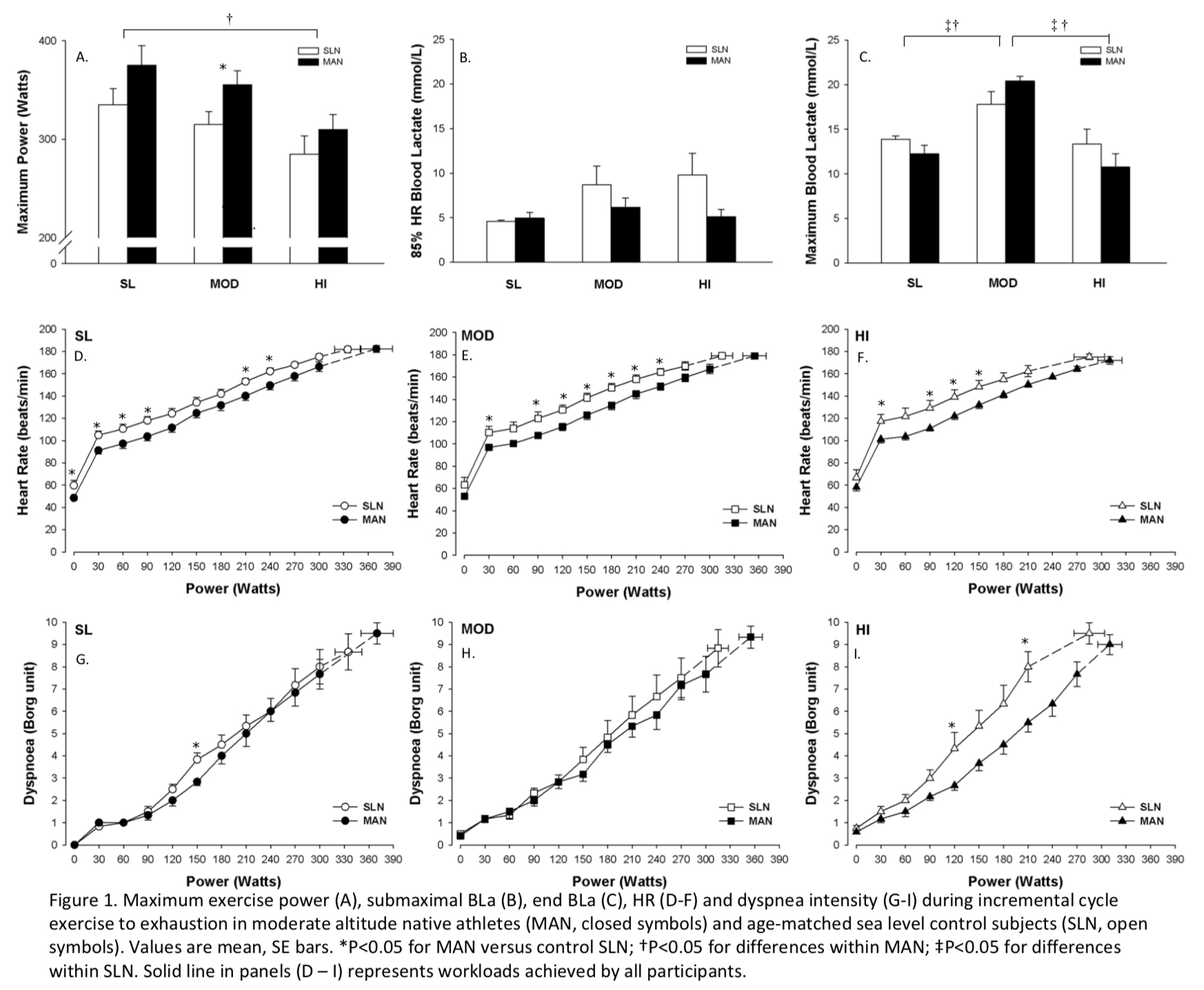Introduction: Despite a growing interest in altitude training to improve athletes’ performance, the impacts of altitude acclimatization and natural hypoxic training on exercise performance in moderate altitude native athletes at sea-level and higher altitudes are not fully understood (Vogt & Hoppeler 2010; Townsend et al. 2016; Park et al. 2016). Aim: This study aimed to examine the potential performance advantage in moderate altitude native athletes over lowlander athletes at different altitudes, and to shed light on the live high-train high (LHTH) model for competitions at varying altitudes. Methods: Twelve elite Ecuadorian inline speed-skaters [6 sea level natives (SLN) and 6 moderate altitude natives (MAN) matched for age, height, weight and performance level] completed 3 incremental cycling exercise tests to exhaustion with measurements of heart rate (HR), blood lactate (BLa), and ratings of perceived exertion (RPE), at sea-level (SL), moderate altitude (MOD, 2700 m), and high altitude (HI,4000 m). Resting haemoglobin (Hb) and haematocrit (Htc) levels were measured at the athlete’s native altitude. Statistical significance was determined using ANOVAs and independent sample t-tests. This study was approved by Manchester Metropolitan University Ethics committee (ethics number:15314). Results: MAN had significantly higher Hb and Htc levels compared to SLN [15.7±0.9 vs. 13.7±0.4 g/dL; 47.2±2.3 vs. 41.3±1.5 %, respectively; p < 0.05 (mean±SD)]. Both SLN and MAN showed progressive reductions in maximum exercise power with increased altitude. However, MAN achieved approximately 10% higher maximum power over SLN at all altitudes with a significant difference between groups at MOD (MAN: 355±35 vs. SLN: 315±31 W, p<0.05) (Figure 1. A). There were no changes in submaximal BLa in MAN at various altitudes while SLN showed steady increase in submaximal BLa with increasing altitude (Figure 1. B). Maximum exercise BLa was similar between groups at all altitudes, and surprisingly BLa was significantly higher at MOD compared to SL and HI in both groups (p<0.5) (Figure 1. C). MAN had significantly lower resting and exercise HRs compared to SLN at all three altitudes (p<0.05) (Fifure 1 D-F). SLN reported greater dyspnoea intensity throughout exercise at high altitude compared to MAN (Figure 1. G-I), while leg discomfort was similar between groups and was not affected by altitude. Discussion & Conclusion: Increased oxygen carrying capacity with altitude acclimatization and hypoxic training as shown by higher Hb and Htc levels and potentially larger stroke volume from lower HR observed in MAN may account for improved exercise performance over SLN (Diebel et al. 2017; Burtscher et al. 2018). Our findings support the LHTH model for improving exercise performance both at altitude and at SL since MAN were able to achieve higher exercise capacity with less physiological perturbation and lower perceived dyspnoea than SLN.
Future Physiology 2020 (Virutal) (2020) Proc Physiol Soc 46, OC06
Oral Communications: Exercise performance of moderate altitude native athletes at varying altitudes
Emma Clare1, Dr. Azmy Faisal1
1 Manchester Metropolitan University, Manchester, United Kingdom
View other abstracts by:
Where applicable, experiments conform with Society ethical requirements.

